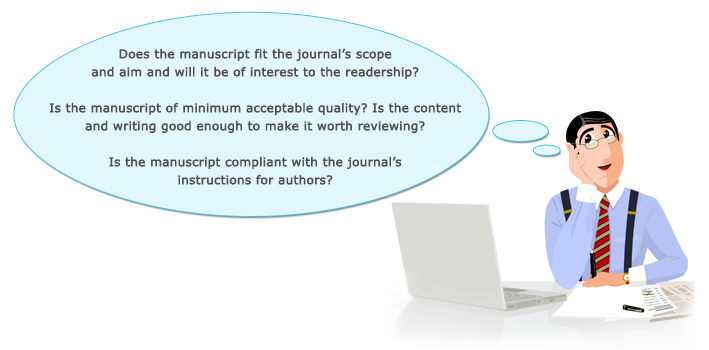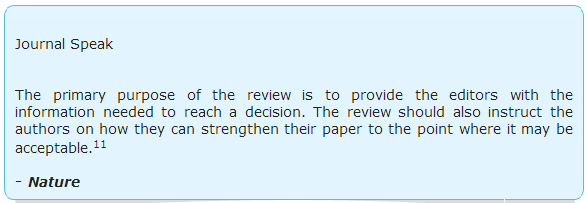What Is One Key Difference Between an Editor and a Peer Reviewer?
Peer review procedure and editorial decision making at journals


Key takeaways:
- Peer review is the procedure by which journals scrutinize and regulate the quality of content they publish, by inviting experts in the field to review and annotate on manuscripts received.
- Manuscripts submitted to a journal first get through an initial screening by the editorial team.
- Those that articulate the screening are sent to at least two experts for peer review.
- Peer reviewers independently make a recommendation to the journal editor as to whether the manuscript should be rejected or accepted (with or without revisions).
- The journal editor considers all the feedback from peer reviewers and makes an informed conclusion to accept or reject the manuscript.
This commodity was originally published in 2013 and is being recirculated every bit part of Peer Review Week 2021.
The peer review process for journal publication is essentially a quality control mechanism. It is a process by which experts evaluate scholarly works, and its objective is to ensure a high quality of published scientific discipline. Even so, peer reviewers do not make the decision to have or refuse papers. At almost, they recommend a decision. At peer-reviewed journals, decision-making authorization rests solely with periodical editors or the periodical'south editorial board. Indeed, it is the journal editor who is considered to be central to the decision making process.1
Journal decision-making process
Typically, after a paper is submitted to a periodical, a journal editor screens the manuscript and decides whether or non to ship information technology for total peer review. Only after clearing the initial screening is the manuscript sent to one or more peer reviewers. Finally, journal editors or the periodical's editorial board consider the peer reviewers' reports and make the terminal decision to accept or pass up the manuscript for publication.

Initial screening
Approximately three million manuscripts are submitted to journals every yr.ane Given the large book of manuscript submissions, more and more than journals follow a policy of screening papers earlier sending them for full peer review. During the initial screening, journal editors mainly check the post-obit:

Peer review
One time a manuscript clears the initial screening, information technology is sent for peer review.
At that place are three common types of peer review for journal publication:
- Single blind: names of reviewers are not revealed to authors
- Double blind: names of reviewers and authors are non revealed to each other
- Open peer review: Names of authors and reviewers are revealed to each other
Editors' decision-making policies vary: some refuse when even one peer reviewer recommends rejection, some when the bulk recommend rejection, and some but when all reviewers recommend rejection.2 In reality, reviewers tend to recommend acceptance more than often than rejection.x Thus, journal editors end up rejecting many papers that peer reviewers actually recommended for publication, with their decisions based on their own opinions of the papers' publication worthiness. The part of peer review is considered to be helping authors ameliorate their manuscripts rather than deciding whether they should be published, which is the periodical editor's task.
It is common for peer reviewers to give conflicting feedback on the same manuscript.8,9 Ane periodical editorial went as far as to say "Unanimity between reviewers is rare."10 In cases of conflicting feedback, the journal editor may choose to send the paper to a third reviewer before arriving at a decision, and the author may have to look longer for the peer review process to be completed.

Decision
Because of a large number of submissions, top-tier journals are often forced to reject even high quality manuscripts for diverse reasons, like a large number of submissions or lack of fit with the journal'south editorial focus.2 While reviewers and editors hands agree on what is clearly not acceptable for publication, deciding what is worthy of publication is a tougher challenge.12 Finally, periodical editors make decisions to take or refuse papers based on their opinion of the papers' publication worthiness and reviewers' comments.ten
Click here to view a short presentation on this topic!
Too meet the following questions in our Q&A forum about the journal editorial process:
- What are the first things journal editors look at in a submission bundle?
- How long should I wait for a response from the journal?
- What is the meaning of "decision in process" condition?
- House of Commons Science and Technology Committee (2011). Peer review in scientific publications Vol 1. House of Eatables: London, UK.
- Schultz DM (2010). Rejection rates for journals publishing in the atmospheric sciences. Message of the American Meteorological Society, 91(two): 231-243. doi: 10.1175/2009BAMS2908.1.]
- Thomson Reuters (2011). Increasing the quality and timeliness of peer review: A report for scholarly publishers [white paper]. Available at: http://scholarone.com/media/pdf/peerreviewwhitepaper.pdf
- Hutchings A (2006). Differences in review quality and recommendations for publication between peer reviewers suggested by authors or by editors. JAMA, 295(3): 314-317.
- Wager East, Parkin EC, Tamber PS (2006). Are reviewers suggested past authors every bit expert as those chosen past editors? Results of a rater-blinded, retrospective study. BMC Medicine, iv: xiii. doi: 10.1186/1741-7015-4-thirteen.
- Association of Learned and Professional Club (2000). Electric current practice in peer review. Results of a survey conducted during October/Nov 2000. Clan of Learned and Professional Society Publishers: Worthing, United kingdom.
- Samet JM (1999). Honey author-advice from a retiring editor. American Journal of Epidemiology, 150(5): 433-436.
- Rothwell PM & Martyn CN (2000). Reproducibility of peer review in clinical neuroscience: Is understanding between reviewers any greater than would exist expected by chance alone? Encephalon, 123(9): 1964–9.
- Ray JG (2002). Judging the judges: The office of journal editors (editorial). Quarterly Journal of Medicine, 95: 769-74.
- Coronel R (1999). The role of the reviewer in editorial decision-making. Cardiovascular Inquiry, 43(2): 261-64. doi: 10.1016/S0008-6363(99)00177-7.
- Nature. Peer-review policy. Last accessed Baronial iv, 2011. Available at: http://world wide web.nature.com/authors/policies/peer_review.html
- Howard L & Wilkinson Yard (1999). Peer review and editorial decision-making. Neuroendocrinology Messages, xx(5): 256-260.
Published on: Nov 04, 2013
Source: https://www.editage.com/insights/peer-review-process-and-editorial-decision-making-at-journals
0 Response to "What Is One Key Difference Between an Editor and a Peer Reviewer?"
Post a Comment